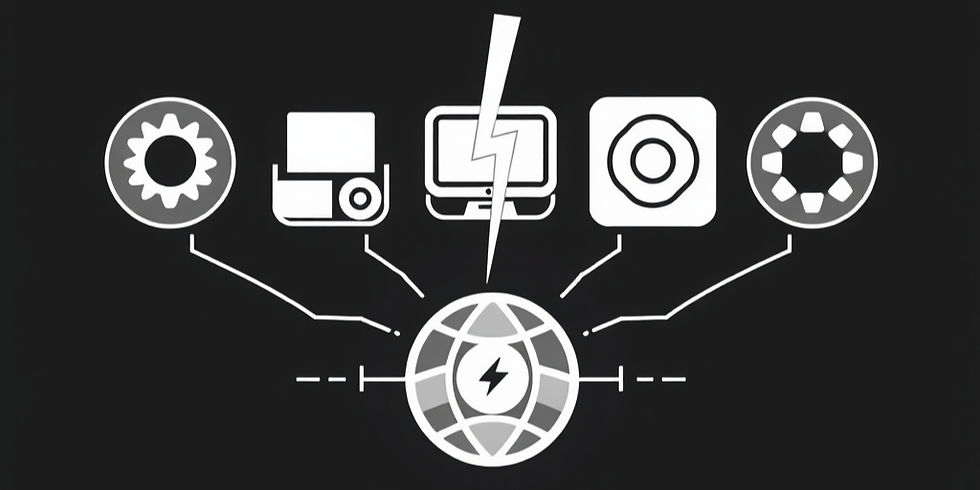Driving Growth: How Marketing, Sales, Operations, and Customer Success Intersect in the Modern Business Engine
- Will Pearlman

- Jun 23
- 7 min read

For managers and directors navigating the complexities of scaling a business, the endeavor often resembles the meticulous management of a sophisticated machine. Within this intricate apparatus, each department—marketing, sales, operations, and customer success—functions as a vital, interconnected component, while data and analytics serve as the essential lubricant, ensuring every part moves with precision and efficiency.
A profound understanding of how these critical functions interweave, coupled with the strategic deployment of the right technological tools, is not merely advantageous; it is utterly crucial for forging a high-performing "business engine" capable of sustained and accelerated growth.
The Interlocking Gears: Each Business Function's Contribution to Driving Growth
Conceive of your organization's departments not as independent silos, but as intricately interlocking gears within an engine as if part of a car. Should even a single gear be misaligned, or suffer a chipped tooth, the entire system's performance will inevitably falter.
The Ignition - Marketing

Marketing, acts as the Ignition, tasked with generating the initial momentum. This involves meticulously cultivating awareness, attracting potential customers through compelling initiatives, and nurturing those prospects with valuable content and precisely targeted campaigns. Without a robust marketing engine effectively firing on all cylinders, the sales team is left with no fuel to convert.
The Transmission - Sales

Sales then assumes the role of the Transmission, converting the promising leads cultivated by marketing into engaged, paying customers. This phase necessitates the skillful cultivation of relationships, a deep understanding of customer needs, and the persuasive articulation of the product or service's unique value proposition. A powerful and well-tuned sales engine ensures that the initial momentum generated by marketing seamlessly translates into tangible, accelerating revenue.
The Chassis - Operations

Operations steps in as the Chassis, providing the foundational structural support and ensuring an overarching efficiency across the entire organizational landscape. This encompasses the critical tasks of streamlining business processes, meticulously integrating diverse systems, and proactively dismantling potential bottlenecks. Without a robust operational foundation, even the most brilliant marketing campaigns and most effective sales efforts risk being undermined by pervasive inefficiencies that drain resources and slow progress.
The Mechanics - Customer Success

Customer Success then becomes the Mechanic, dedicated to ensuring that customers not only adopt but truly achieve their desired outcomes using the purchased product or service. This vital function directly drives customer retention, significantly reduces churn rates, and fosters a powerful culture of customer advocacy—all of which are indispensable for fueling long-term, sustainable, and organic growth through repeat business and referrals.
The Oil - Data & Analytics

Finally, Data & Analytics serves as the Essential Oil, providing the continuous stream of insights necessary to optimize every single aspect of this intricate "business engine." It involves the systematic collection, rigorous analysis, and intuitive visualization of information to discern precisely what strategies are yielding positive results, pinpoint areas of underperformance, and accurately identify where strategic improvements are most urgently needed. Without the constant flow of data, critical business decisions would regrettably be made in the dark, based on intuition rather than informed intelligence.
The Toolkit: Essential Technologies Powering Each Function
While the strategic alignment of these functions is paramount, each also requires a sophisticated array of technological tools to operate with peak effectiveness. Yet, merely possessing these tools is insufficient; their seamless integration across departmental boundaries is just as vital as the individual capabilities of the tools themselves.
For Marketing, the attraction and engagement efforts are significantly amplified by powerful marketing automation platforms such as HubSpot Marketing Hub, Marketo, or Salesforce's B2B Marketing Automation (formally Pardot). These serve as central hubs for orchestrating intricate campaigns, nurturing leads through personalized journeys, and automating a myriad of routine marketing tasks. Content creation and management are foundational, relying on robust Content Management Systems like WordPress, Wix, or HubSpot CMS for crafting and organizing website content, blog posts, and various marketing collateral.
To ensure discoverability, specialized SEO tools including SEMrush and Ahrefs are indispensable for optimizing website content and elevating search engine rankings. Targeted communication is facilitated by email marketing platforms, often integrated within the larger MAPs or operating as standalone tools such as Mailchimp, enabling the delivery of personalized messages. Finally, social media management tools like Hootsuite and Sprout Social are crucial for scheduling posts, fostering engagement with audiences, and meticulously tracking performance across diverse social channels.
In the realm of Sales, the imperative is to convert and close opportunities.
The CRM, or Customer Relationship Management system—exemplified by HubSpot Sales Hub or Salesforce Sales Cloud—stands as the central repository for every customer interaction, meticulous deal tracking, and precise sales forecasting. To fuel the top of the sales funnel, sales intelligence platforms like ZoomInfo and Apollo.io are invaluable for identifying promising potential leads and compiling essential contact information.
Streamlined outreach is enabled by email sequencing tools such as Salesloft and Outreach.io, which automate personalized email communications to prospects. Sales enablement platforms are critical for equipping sales representatives with the precise content and resources they need to confidently present solutions and successfully close deals. Finally, e-signature tools like DocuSign and Adobe Sign significantly streamline the contract signing process, accelerating deal closure.

Operations, encompassing the critical functions of BizOps and RevOps, is fundamentally about streamlining and aligning the entire enterprise. This mission is driven by Integration Platform as a Service (iPaaS) solutions like Zapier, Workato, and Vertify, which are indispensable for connecting disparate systems and automating complex workflows across various departments.
For day-to-day coordination, project management tools such as Asana and Monday.com are vital for managing projects and individual tasks across diverse teams. The infrastructure for data-driven insights relies on Business Intelligence (BI) tools like Tableau, Power BI, and Klipfolio for constructing cohesive dashboards and creating precise reports to track key performance indicators (KPIs).
Within Customer Success, the focus shifts to retaining and growing the existing customer base. This begins with robust onboarding and adoption processes guiding new customers through initial setup and ensuring rapid time-to-value. Ongoing relationship management and engagement are maintained through proactive outreach, health scoring, regular check-ins, and the identification of upsell or cross-sell opportunities, often managed within CSPs and CRMs, complemented by communication platforms like Intercom or Zendesk, and feedback gathering through survey tools like SurveyMonkey.
Retention and churn prevention are driven by monitoring customer health metrics within CSPs and executing proactive strategies. Lastly, fostering advocacy and expansion involves identifying and nurturing customer champions, encouraging positive reviews, managing referral programs, and promoting expanded feature adoption.
Underpinning all these functions are the essential Data & Analytics Tools, which serve as the very foundation for intelligent decision-making across the entire business. Data collection and integration are managed by ETL (Extract, Transform, Load) tools like Fivetran and Stitch, or through iPaaS solutions, which move and prepare data from various sources (CRM, marketing platforms, product usage, finance) into a central repository, ensuring cleanliness and consistency.
This data is then securely stored and managed in scalable Data Warehouses like or Data Lakes, ensuring accessibility and performance. The crucial step of data analysis and visualization relies on powerful Business Intelligence (BI) platforms to enable the discovery of insights, identification of trends, and the creation of intuitive dashboards and reports for diverse stakeholders.
Forging a High-Performance Business Engine
The true sign of success in the modern business landscape does not merely lie in the acquisition of these advanced tools; it resides profoundly in their seamless integration and, more critically, in the orchestrated collaboration of the teams entrusted with their operation.
Achieving this demands a concerted effort to encourage open communication and foster genuine collaboration between departments . Marketing specialists, for instance, must possess an intrinsic understanding of the sales team's evolving needs, just as sales professionals benefit immensely from awareness of ongoing customer success efforts.
Furthermore, it is imperative to establish clearly defined processes that fluidly span departmental boundaries. The handoff of a qualified lead from marketing to sales, for example, must be governed by clearly articulated criteria and established protocols, ensuring a smooth transition without friction or dropped opportunities.
A core strategic imperative involves centralizing data, striving relentlessly for a "single source of truth" for all critical customer information. While the CRM often serves as this central repository, its effectiveness hinges on proper planning and integration with every other relevant system across the enterprise, ensuring data consistency and accuracy across all touchpoints.

Wherever feasible, strategic automation should be embraced. Leveraging automation tools to streamline repetitive, manual tasks not only increases efficiency but also liberates valuable employee time, allowing your team to focus on higher-value, more strategic initiatives that directly contribute to growth and innovation.
A relentless focus on measurement is non-negotiable. Meticulously track key performance indicators (KPIs) not just for individual departments, but for the business as a whole. This data-driven approach empowers leaders to pinpoint areas for improvement with precision, identify emerging trends, and make informed, agile decisions.
Moreover, a sustained investment in comprehensive training is vital. Ensure that every employee is not only proficient in utilizing the tools available to them but also understands the broader strategic context of their work within the integrated "business engine." This fosters greater engagement and effectiveness.
Finally, cultivating a pervasive culture of continuous improvement is paramount. Regularly and systematically review all processes, reassess the efficacy of your technological toolkit, and analyze your data to identify ongoing opportunities for optimization. This iterative approach ensures your business engine remains finely tuned and highly adaptable to evolving market demands.
The Transformative Power of Integration: Making the Engine Roar
When the functions of marketing, sales, operations, and customer success are aligned and seamlessly powered by thoughtfully integrated tools and a unified data strategy, the collective results can be truly transformative for any scaling business.
The synergy leads to increased revenue as a streamlined sales process, consistently fueled by high-quality leads from marketing and robustly supported by efficient operations, directly translates into a higher volume of closed deals and accelerated revenue growth. Simultaneously, a strong and proactive customer success function, consistently armed with actionable data and empowered by the right tools, ensures that customers remain engaged, successful, and satisfied, leading to significantly improved customer retention and a powerful base for recurring revenue.
The benefits extend deeply into internal efficiency; comprehensive automation and seamless integration drastically increase overall efficiency by minimizing manual tasks, reducing errors, and eliminating redundant efforts across departments. This frees up invaluable employee time, allowing teams to dedicate their energy to higher-value, more strategic activities. Furthermore, the availability of clear, actionable, and centralized data translates directly into better decision-making.
Managers and directors gain unparalleled insights, enabling them to make truly informed strategic choices regarding market positioning, resource allocation, and future investments. Ultimately, a diligently built and meticulously maintained "business engine" is inherently designed for sustainable and scalable growth. It possesses the inherent capacity to absorb and effectively handle increased demand without succumbing to operational breakdowns or diminishing returns, paving the way for continued expansion and long-term success.
To learn more about how the experts at Will Pearlman Consulting can help design, build, optimize, or fix your business engine contact us today for a Free Consultation.




Comments